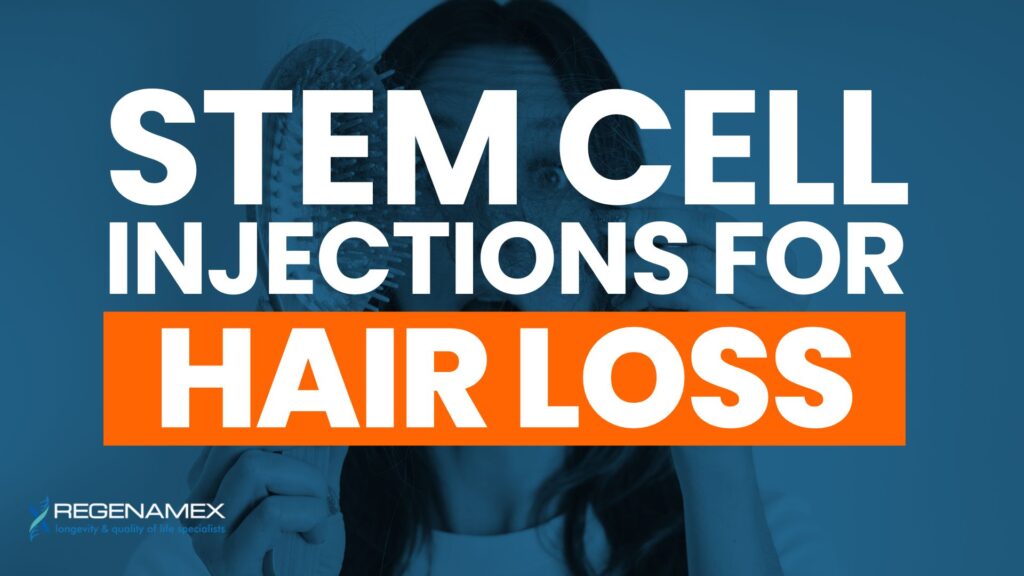
Stem Cell Injections for Hair Loss
Stem cell injections for hair loss are rapidly drawing attention as a next-generation option to combat baldness and thinning. Instead of relying solely on topical treatments or hair transplants, regenerative approaches aim to stimulate dormant follicles and repair follicular structures at a cellular level. Through the use of mesenchymal stem cells (MSCs) and supportive biologics, patients may see renewed hair growth, increased density, and improved scalp health. Regenamex, a leading clinic in Mexico, is among the facilities offering this advanced therapy with rigorous safety oversight.
This approach goes beyond covering up hair loss symptoms — it targets cellular dysfunction and inflammation in the scalp. MSCs derived from ethically sourced placental tissue and Wharton’s jelly carry anti-inflammatory, immunomodulatory, and tissue-regenerative signals. When injected into the scalp, these cells can support blood flow, activate resting follicle stem cells, and enhance the microenvironment so hair regrowth becomes possible. Combined with Regenamex’s protocols and quality controls, stem cell injections for hair loss represent one of the most promising regenerative treatments available today.
How Hair Loss Happens and Why Regeneration Matters

Hair loss (alopecia) can occur for many reasons — from genetics and hormonal fluctuations to chronic stress and environmental damage. Over time, these factors disrupt the natural hair growth cycle, causing follicles to shrink, weaken, and eventually stop producing healthy hair. In conditions such as androgenetic alopecia (pattern baldness), the miniaturization of hair follicles is driven by hormonal sensitivity, particularly to dihydrotestosterone (DHT). As follicles lose blood supply and oxygen, their internal stem cell populations—responsible for follicle regeneration—become less active. This leads to thinner hair strands and progressively larger areas of baldness.
Traditional treatments like minoxidil and finasteride may slow this process, but they rarely rebuild damaged follicles or restore lost density. That’s where regenerative medicine offers a new frontier. Using the body’s own healing mechanisms, stem cell injections for hair loss activate dormant follicle stem cells and rejuvenate scalp tissue. Mesenchymal stem cells (MSCs), in particular, release powerful bioactive molecules that repair cellular damage, enhance microcirculation, and create a healthier scalp environment. By addressing the biological causes of alopecia, stem cell therapy gives patients a chance to regrow stronger, thicker, and more resilient hair naturally.
Understanding Stem Cell Injections for Hair Loss
During a stem cell injection for hair loss, a clinician carefully administers a concentrated suspension of mesenchymal stem cells—or their regenerative secretions—directly into thinning scalp areas. The treatment typically involves multiple micro-injections across affected zones, ensuring even distribution and coverage. Once delivered, the cells release growth factors, cytokines, and anti-inflammatory molecules that help awaken dormant follicles and improve blood flow. Clinics like Regenamex often pair this therapy with platelet-rich plasma (PRP) or exosome treatments, which enhance the regenerative effect and accelerate visible results.
Some modern approaches use conditioned media, meaning the fluid produced by cultured stem cells instead of the cells themselves. This solution contains the same powerful signaling molecules responsible for regeneration, without introducing living cells. Studies have shown that this method can significantly increase hair thickness and follicle density, especially in early-to-moderate hair loss cases. Whether live MSCs or their bioactive secretions are used, both strategies share the same goal — to restore the scalp’s vitality and help follicles return to active growth.
Mechanisms of Action
The effectiveness of stem cell therapy for hair loss lies in its multifaceted mechanisms. Mesenchymal stem cells are not just regenerative — they’re intelligent communicators that send biochemical signals to nearby cells, encouraging repair and renewal. One of their most important roles is reducing chronic scalp inflammation, which often contributes to follicle inactivity. By releasing anti-inflammatory cytokines, MSCs calm overactive immune responses that may be damaging follicles. This creates a healthier scalp environment where follicles can thrive once again.
In addition to modulating inflammation, stem cells promote angiogenesis — the formation of new blood vessels. This enhanced circulation ensures follicles receive the oxygen and nutrients they need to produce strong, healthy strands. Moreover, growth factors like VEGF and IGF-1 secreted by MSCs help reawaken follicular stem cells within the “bulge” region of the follicle, encouraging them to transition from the dormant (telogen) phase to the active growth (anagen) phase. The result is thicker hair shafts, increased density, and visible improvement over time.
Clinical Evidence & Research
Clinical research supporting stem cell-based hair restoration has grown rapidly in recent years. Human trials have shown that MSC therapy can significantly improve both hair density and follicle health. A systematic review published in peer-reviewed medical journals found that stem cell-derived therapies consistently led to noticeable regrowth and improved scalp condition. In Japan, a double-blind study involving follicular stem cell (HF-MSC) injections demonstrated visible thickening and restoration in patients with androgenetic alopecia within just 12 weeks. These results highlight the potential of cellular therapy to reverse key aspects of hair loss biology.
Preclinical research has also provided compelling evidence. Studies on animal models have shown that stem cell therapy not only repairs damaged follicles but can also encourage the formation of new ones through enhanced vascular and tissue regeneration. Other clinical findings reveal that combining MSC therapy with energy-based treatments or PRP amplifies results by accelerating follicular turnover and increasing scalp nutrient delivery. Although large-scale standardization is still ongoing, early research confirms that stem cells represent one of the most promising frontiers in hair regeneration science.
While stem cell injections for hair loss show tremendous promise, they are not an instant or universal cure. Several factors — such as the extent of follicle damage, patient age, and hormonal environment — influence how well an individual responds. In patients where follicles have completely scarred or disappeared, full regeneration may be limited. Some studies also note that results may diminish over time without proper maintenance, suggesting periodic booster treatments can help sustain long-term growth.
Regenamex’s Approach to Hair Regrowth

Regenamex is redefining the standard for stem cell therapy in Mexico through its advanced approach to hair restoration. The clinic uses mesenchymal stem cells derived exclusively from Wharton’s jelly and placental tissue, two of the richest and most potent sources of regenerative cells. These MSCs possess exceptional anti-inflammatory and tissue-repair capabilities, helping to restore follicular function and scalp vitality. Every batch of cells is processed under Good Manufacturing Practice (GMP) standards and overseen by COFEPRIS, Mexico’s national health authority, ensuring that patients receive the highest level of safety and quality.
What sets Regenamex apart is its comprehensive treatment model. Instead of focusing on stem cells alone, the clinic combines them with complementary therapies such as platelet-rich plasma (PRP), exosomes, micro-needling, and IV nutrition. This multi-layered strategy enhances cellular communication and maximizes follicular response. Patients can also take advantage of Regenamex’s Fly & Buy Program, which provides travel coordination, transparent pricing, and personalized aftercare. Together, these elements make Regenamex one of the best-regulated and most effective destinations in the world for stem cell-based hair restoration.
Protocol & Patient Journey
Pre-Treatment Evaluation
Every successful stem cell therapy begins with a comprehensive evaluation. At Regenamex, patients undergo a detailed consultation that includes scalp imaging, medical history review, and lab tests to rule out any underlying causes of hair loss such as thyroid imbalances, nutritional deficiencies, or autoimmune disorders. This step ensures the treatment plan is customized for maximum safety and results. By identifying contributing factors early, physicians can design a targeted approach that optimizes both the regenerative response and long-term hair health.
Treatment Delivery & Recovery
The treatment itself is straightforward and minimally invasive. On the day of the procedure, the scalp is prepped, sometimes with gentle micro-needling to improve cell absorption. The clinician then injects the MSC solution or conditioned media into areas of thinning using fine micro-needles. The process typically takes under an hour, with minimal discomfort. Afterward, patients may experience mild tenderness or swelling that subsides within 24 to 48 hours. Most can resume daily activities immediately.
Follow-up appointments are scheduled to track progress, with visible improvements in density and texture usually emerging within two to three months. Depending on the patient’s needs, booster injections may be recommended at six or twelve months to prolong results. Regenamex’s patient-centered model ensures continuous monitoring and personalized adjustments throughout recovery.
Benefits & Risks
Stem cell injections for hair loss offer a non-surgical, natural, and regenerative alternative to transplants and medications. The therapy can reactivate dormant follicles, promote the growth of new strands, and improve scalp circulation. Many patients notice thicker hair, reduced shedding, and improved texture within weeks of treatment. Because the process harnesses biologically compatible stem cells, it promotes healing without introducing foreign substances or major side effects.
Beyond cosmetic improvement, stem cell therapy can enhance scalp health at a deeper level. By restoring blood flow and balancing the local immune environment, it supports long-term follicular stability and reduces the inflammation that contributes to future hair loss. When performed in a regulated clinic like Regenamex, patients enjoy not just visible results but also the reassurance of medical-grade care and ethical treatment standards.
Though generally safe, stem cell injections for hair loss can have minor side effects such as temporary redness, swelling, or sensitivity in the treated area. These symptoms typically resolve within a few days. Results also vary from patient to patient — while some experience substantial regrowth, others may see only moderate improvements. Factors like age, genetics, and scalp condition can influence the overall outcome.
How to Choose a Reputable Clinic
Choosing the right clinic is crucial for achieving safe and lasting results with stem cell injections for hair loss. Patients should start by confirming that the facility operates under proper regulatory oversight, such as COFEPRIS in Mexico, and follows GMP standards for stem cell processing. Clinics that use ethically sourced placental or Wharton’s jelly MSCs provide superior regenerative potential compared to those relying on unverified or autologous (self-harvested) sources.
Equally important is the clinic’s transparency regarding its methods and outcomes. Reputable providers like Regenamex offer before-and-after photos, clear treatment plans, and realistic expectations rather than exaggerated promises. The inclusion of complementary therapies such as PRP, exosomes, or IV nutrition further supports comprehensive care. For international patients, Regenamex’s travel assistance and aftercare services make the entire process seamless from arrival to follow-up. By choosing a regulated, patient-centered clinic, individuals can experience hair restoration that’s both safe and scientifically grounded.
FAQs: Stem Cell Injections for Hair Loss
Stem cell injections for hair loss are an innovative regenerative treatment that targets the root biological causes of thinning hair. The procedure involves delivering mesenchymal stem cells (MSCs) directly into the scalp, where they interact with dormant hair follicles and the surrounding tissue environment. These MSCs release powerful bioactive molecules—such as growth factors and cytokines—that help restore the scalp’s health, stimulate new follicle activity, and promote natural hair growth.
Stem cell therapy for hair loss works through the natural regenerative power of mesenchymal stem cells. Once injected into the scalp, these MSCs begin to release growth factors and signaling molecules that influence nearby cells. They essentially “reprogram” dormant hair follicle cells to re-enter the growth phase (known as the anagen phase) and restore their ability to produce new hair strands. In addition to stimulating follicles, MSCs also create a healthier scalp microenvironment by improving blood circulation and reducing oxidative stress and inflammation.
Stem cell injections for hair loss are considered very safe when performed in a regulated and certified clinic such as Regenamex. The clinic operates under strict COFEPRIS oversight, ensuring that all procedures are carried out using ethically sourced and properly processed mesenchymal stem cells derived from Wharton’s jelly and placental tissue. These cells are rigorously tested for sterility, viability, and purity before use, significantly minimizing the risk of adverse effects.
Ideal candidates for stem cell injections are individuals experiencing early to moderate stages of hair thinning or pattern baldness, where hair follicles are still present but inactive. This includes men and women with androgenetic alopecia, postpartum hair loss, or diffuse thinning due to stress, aging, or hormonal changes. Patients with underlying scalp inflammation, poor circulation, or autoimmune conditions that affect follicle function may also benefit from the regenerative properties of MSC therapy.
The timeline for visible results varies by individual, but many patients begin noticing early improvements within the first few weeks after treatment. These initial changes may include reduced hair shedding, improved scalp health, and a thicker texture to existing strands. As the regenerative process continues, new hair growth typically becomes noticeable within two to four months, with density and coverage improving gradually over six to twelve months.
The results of stem cell therapy for hair loss are long-lasting, often extending for one to two years or more, depending on the patient’s health, lifestyle, and stage of hair loss. Unlike medications that lose efficacy when discontinued, stem cell treatments promote natural regeneration that persists over time. As follicles are reactivated and scalp inflammation decreases, many patients continue to enjoy fuller, stronger hair even months after their final session.

